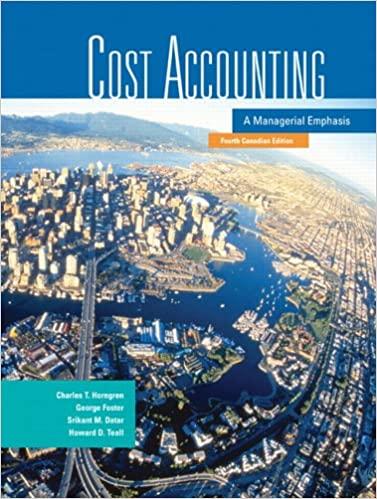Goal-congruence, taxes, different market conditions. The $askatchewan Corporation makes water pumps. The Engine Division makes the engines
Question:
Goal-congruence, taxes, different market conditions. The $askatchewan Corporation makes water pumps. The Engine Division makes the engines and supplies them to the Assembly Division where the pumps are assembled. $askatchewan is a successful and profitable corporation that attributes much of its success to its decentralized operating style.
Each division manager is compensated on the basis of division operating income.
The Assembly Division currently acquires all its engines from the Engine Division.
The Assembly Division manager could purchase similar engines in the market for $480.
The Engine Division is currently operating at 80% ofits capacity of 4,000 units and has the following particulars:
Direct materials ($150 per unit X 3,200 units) $480,000 Direct manufacturing labour ($60 per unit X 3,200 units) 192,000 Variable manufacturing overhead costs ($30 per unit X 3,200 units) 96,000 Fixed manufacturing overhead costs 624,000 All the Engine Division’s 3,200 units are currently transferred to the Assembly Division. No engines are sold in the outside market.
The Engine Division has just received an order for 2,000 units at $450 per engine that would utilize halfthe capacity of the plant. The order has either to be taken in full or rejected totally. The order is for a slightly different engine than what the Engine Division currently makes but takes the same amount of manufacturing time. To produce the new engine would require direct materials per unit of $120, direct manufacturing labour per unit of $48, and variable manufacturing overhead costs per unit of $30.
Instructions Form groups of two or three students to complete the following requirements.
Required 1. From the viewpoint of the Saskatchewan Corporation as a whole, should the Engine Division accept the order for the 2,000 emits?
2. What range of transfer prices result in achieving the actions determined to be optimal in requirement 1, if division managers act in a decentralized manner?
3. The manager of the Assembly Division has proposed a transfer price for the engines equal to the full cost of the engines including an allocation of overhead costs. The Engine Division allocates overhead costs to engines on the basis of the total capacity of the plant used to manufacture the engines.
a. Calculate the transfer price for the engines transferred to the Assembly Division under this arrangement.
b. Do you think that the transfer price calculated in requirement 3
(a) will result in achieving the actions determined to be optimal in requirement 1, if division managers act in a decentralized manner?
c. Comment in general on one advantage and one disadvantage of using full costs of the producing division as the basis for setting transfer prices.
4. Now consider the effect ofincome taxes.
a. $uppose the Assembly Division is located in a country that imposes a 10% tax on income earned within its boundaries, while the Engine Division is located in a country that imposes no tax on income earned within its boundaries. What transfer price would be chosen by the $askatchewan Corporation to minimize tax payments for the corpo¬
ration as a whole? Assume that only transfer prices that are greater than or equal to full manufacturing costs and less than or equal to the market price of “substantially similar”
engines are acceptable to the taxing authorities.
b. Suppose that the Saskatchewan Corporation announces the transfer price computed in requirement 4
(a) to price all transfers between the Engine and Assembly Divisions.
Each division manager then acts autonomously to maximize division operating income.
Will division managers acting in a decentralized manner achieve the actions determined to be optimal in requirement 1 ?
5. Consider your responses to requirements 1 to 4 and assume the Engine Division will continue to have opportunities for outside business as described in requirement 1. What transfer-pricing policy would you recommend Saskatchewan use and why? Would you continue to evaluate division performance on the basis of division operating incomes?
Step by Step Answer:

Cost Accounting A Managerial Emphasis
ISBN: 9780131971905
4th Canadian Edition
Authors: Charles T. Horngren, George Foster, Srikant M. Datar, Howard D. Teall





